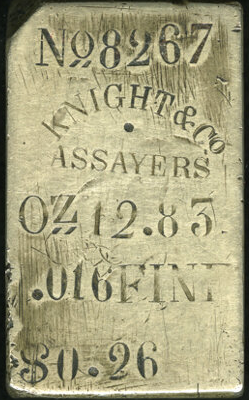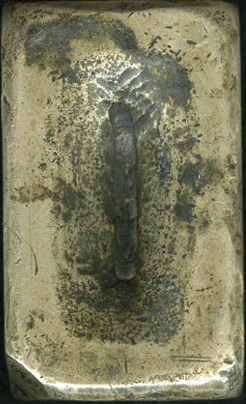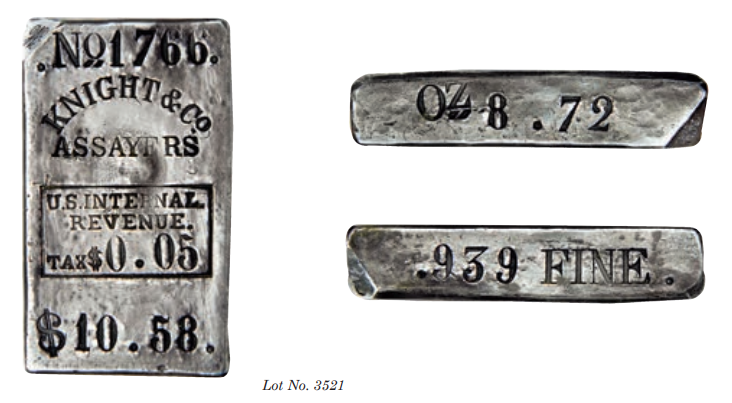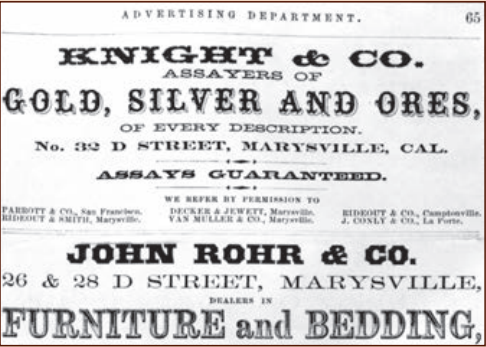Knight formed a partnership with experienced California and Nevada assayer H. Harris in Marysville. Knight’s early work in Unionville, Nevada Territory, gave him the experience necessary to run his own assay business, and he bought Harris’ Marysville Pioneer Assay Office in 1863 after spending part of a year in Unionville. Harris went on to establish assay offices in Carson City, Aurora, Silver City, and Gold Hill.
12.83 oz Knight & Co. Silver Ingot, Unionville, Nevada. $0.26 Monetized, c1867


The recent discovery and subsequent research and testing of a David Knight Marysville, California assayer ingot, circa 1863-1865, held by a member of the Marysville Knight family for more than 135 years sheds new light on the western assayer business, inter-mining camp business transitions, and the need to promote the mines of Nevada Territory and California to the world just a few years after the discovery of the Comstock Lode. A professional paper was recently published by Fred Holabird regarding the testing and analysis of this ingot.
This Knight ingot possesses an anomaly in that only one of the customary two precious metal values is reported on the ingot’s face. Other attributes of the ingot conform exactly to standards set by custom over a several hundred-year period, particularly the many decades of and after the California Gold Rush, as illustrated by the ingots of the SS Central America. Scientific analysis of the ingot, coupled with an exact match of the assay data in the published historical record of the 1867 Paris Exposition, indicate that this ingot was made in Unionville. Historical records further indicate that the ingot may have been made for and on display at the great Paris International Exhibition of 1867. The ingot was found to have a trace amount nickel-cobalt anomaly typical of and unique to Unionville area silver ores. Light gray overall with deeper gray patina in the more recessed areas, including the devices. Only one side of the ingot has an imprint, the top side.
It reads: No 8267 / KNIGHT & Co / ASSAYERS / OZ 12.83 / .016 FINE / $0.26. As referred to above, only one precious metal is indicated on this ingot, the gold content. It’s a curious way of stating the silver content, that is, by inference, and perhaps that is the reason it was not done on other ingots.
From The Alan Bingel Collection.
NOTE: The presence of so many what appear to be counterfeit Knight Ingots calls into question every other one, although it is possible that this particular ingot is of genuine origin, it requires further research and review.
[07/2005] https://coins.ha.com/itm/territorial-gold/knight-and-co-silver-ingot-unionville-nevada-the-recent-discovery-and-subsequent-research-and-testing-of-a-david-knight-ma/a/382-10479.s ($25,300)
8.72 oz Knight & Company, Assayers. Marysville, California. Silver assay
ingot no. 1766.

Overall appearance of a nice Very Fine with deep gray
toning. Good care taken with the face, back shows a deep central cooling
depression. This is a very fine looking ingot, well made with chamfered
edges and all faces polished save the back which has been allowed to
remain in its “natural” state. Opposing corners clipped and, unusually,
signed, with a monogram that Mr. Ford interpreted as A.M. (for Agosthon
Molitor). This is one of the rare ingots that shows the Office of Internal
Revenue tax paid in a form other than the conventional round OIR stamp
(the Riehn, Hemme bar to follow is the other). The rectangular tax paid
notation on this bar suggests the absence of regular OIR stamps yet the
need to annotate specie bars in accordance with the law of June 30, 1864.
The cataloguer suggests this bar was made soon after the law had come
into effect, but before local assessors had received the familiar round OIR
stamps they were to issue to assayers, probably in the period September
to December, 1864.
- Face: No. 1766. / KNIGHT & Co. / ASSAYERS / [the following within a square outline] U.S. INTERNAL / REVENUE. / TAX $0.05 / $10.58.
- Back: blank.
- Top side: blank.
- Bottom side: blank.
- Left side: OZ. 8.72.
- Right side: .939 FINE.
- Dimensions: 60.9 x 36.2 x 13.0 mm.
- Current weight: 271.0 gms.
Ex B. Max Mehl on January 28, 1923 to John Work Garrett, Garrett Collection (Bowers & Ruddy, March 25, 1981, lot 1947.
STOLEN
Shortly before this catalogue went to press, this and four other ingots from the Ford Collection were stolen during transit. Since they had already been photographed and described, Stack’s decided to retain their lot descriptions in this catalog in order to preserve their numismatic evidence for future researchers and to aid in their hoped recovery.
While the silver examples of Knight & Co are believed to be real / genuine, the gold examples are not. See the ‘Fantasy’ category of Knight & Co to review those examples below.

